The art of crafting the perfect Vietnamese egg coffee has long captivated coffee enthusiasts worldwide. Mastered by skilled baristas, this beloved beverage’s essence lies in the meticulous techniques used to separate and whip egg whites and yolks, creating a lush, creamy foam that crowns the robust coffee. Balancing the bitterness of the brew with the rich, velvety sweetness of condensed milk and raw honey requires exceptional timing and precision. The final presentation, with its visually captivating layers and aromatic garnishes, elevates this specialty into a true sensory delight. Unraveling the secrets behind this captivating process offers a glimpse into the cultural heritage and artistry that define the Vietnamese egg coffee experience.
Key Points

-
Skilled baristas carefully separate egg whites and yolks, whipping them to stiff peaks and light, frothy consistency, respectively, to create a luscious, velvety texture.
-
Meticulous timing and technique in whipping the egg whites are essential to transform them from watery to rich, creamy foam, balancing the coffee’s bitterness.
-
The harmonious blending of freshly brewed Vietnamese coffee and the whisked egg yolk and condensed milk mixture creates a rich, creamy egg custard.
-
The addition of raw coffee blossom honey to the egg yolk mixture provides a delicate sweetness that complements the robust coffee flavor.
-
Precise presentation with silky, golden foam atop the creamy egg custard, and garnishes like cocoa powder or cinnamon, elevate the traditional Vietnamese treat.
Origins of Egg Coffee
The origins of Vietnamese egg coffee, a unique blend of strong Vietnamese coffee and a creamy egg yolk-based foam, can be traced back to the 1950s in Hanoi.
During this time, the country was facing a shortage of milk, so enterprising Vietnamese chefs began experimenting with alternative ingredients to create a rich, creamy coffee drink.
They discovered that whisking egg yolks into the coffee produced a luxurious, velvet-like texture that complemented the bold flavor of the brew.
This innovation became a beloved specialty in Hanoi, and soon spread to other parts of Vietnam.
Today, egg coffee remains a cherished part of the country’s vibrant cafe culture, showcasing the ingenuity and adaptability of Vietnamese culinary traditions.
Here are more great tours and experiences we've reviewed in Ho Chi Minh City
Egg Separation Technique
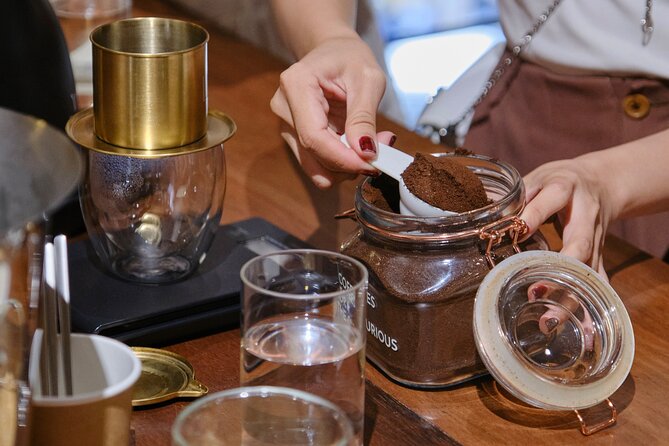
Skilled baristas skillfully separate the egg whites from the yolks, ensuring a rich and creamy texture in the Vietnamese egg coffee. This delicate process involves carefully cracking the eggs and gently separating the components. The yolks are then whipped until light and frothy, while the whites are whipped to stiff peaks. This creates a luscious, velvety mouthfeel that perfectly complements the bold flavor of the Vietnamese coffee.
| Steps | Technique |
|---|---|
| 1. Crack Eggs | Gently split eggs, separating whites and yolks |
| 2. Whip Yolks | Whip yolks until light and frothy |
| 3. Whip Whites | Whip whites to stiff peaks |
| 4. Combine | Fold whipped whites into whipped yolks |
| 5. Serve | Pour over Vietnamese coffee for signature texture |
Perfecting Egg Whipping
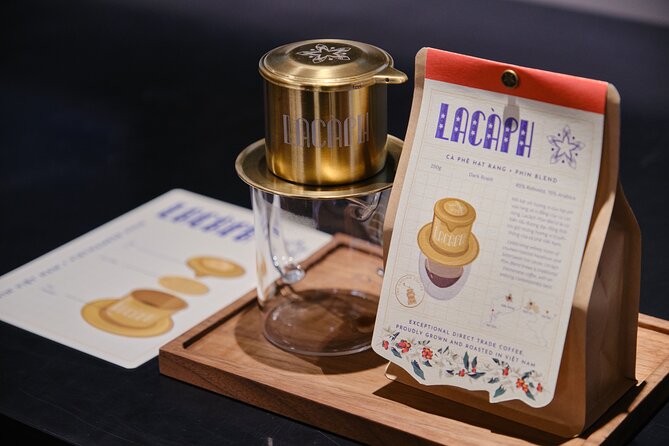
With a deft hand, the baristas whip the egg whites to airy perfection, coaxing them into stiff, glossy peaks that lend a velvety, indulgent texture to the Vietnamese egg coffee.
The technique requires meticulous attention and a keen sense of timing. As the whites are whisked, they transform from a watery consistency into a rich, creamy foam that caps the robust, dark-roasted coffee.
Properly whipped, the egg adds a luxurious mouthfeel and subtle sweetness that perfectly balances the coffee’s bitterness. It’s a delicate dance that takes practice to master, but the resulting drink is a sublime symphony of flavors and textures that has made Vietnamese egg coffee a beloved tradition.
Blending Coffee and Cream
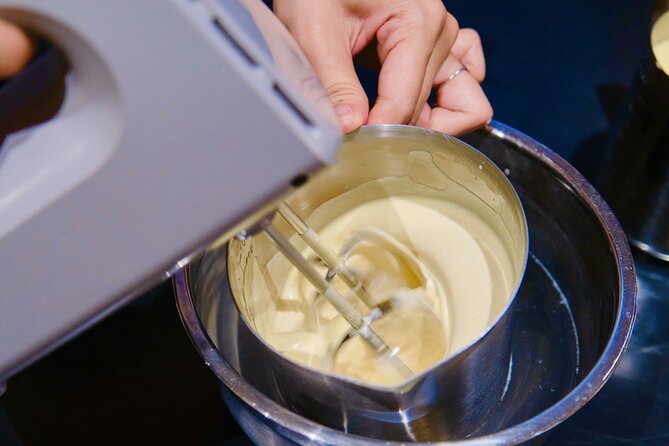
Blending the robust Vietnamese coffee and the velvety egg custard requires a delicate touch, as the baristas deftly combine the two components to create the signature Vietnamese egg coffee. The careful balancing act involves pouring the freshly brewed coffee over the silky egg mixture, ensuring the flavors meld seamlessly.
| Step | Action | Outcome |
|---|---|---|
| 1 | Brew strong Vietnamese coffee | Robust, intense coffee flavor |
| 2 | Whisk egg yolks and condensed milk | Rich, creamy egg custard |
| 3 | Slowly pour coffee over egg mixture | Blending of coffee and cream |
The resulting beverage is a harmonious blend of bold coffee and lush, decadent cream, delighting the senses and showcasing the artistry of Vietnamese coffee culture.
Sweetening the Brew

The baristas at Lac’aph expertly incorporate raw coffee blossom honey to impart a delicate sweetness that complements the robust Vietnamese coffee. This natural sweetener is harvested from the blossoms of coffee plants, lending subtle notes of caramel and floral that harmonize beautifully with the coffee’s bold, earthy flavors.
The honey is added to the egg yolk mixture, creating a luscious, creamy texture that coats the palate. This balance of sweet and savory elevates the traditional Vietnamese egg coffee, providing a truly unique sensory experience.
The result is a decadent beverage that delights the senses, offering a harmonious blend of flavors in every sip.
- Cu Chi Tunnels & Mekong Delta Group Tour Full Day
- From Ho Chi Minh: Full-Day Vung Tau Beach & The Giant Jesus
- From Ho Chi Minh: Vung Tau Beach – The Most Beautiful Beach
- From HCM: Mekong Delta & Cai Rang Floating Market 2-Day Tour
- Enjoy the Sunshine With Vung Tau Beach Private Day Tour
- Private Transfer From HO CHI MINH to MUINE
Presentation and Garnishing
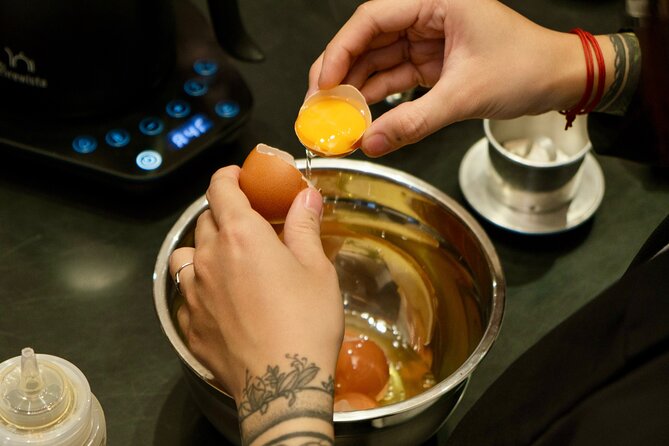
Beyond the delightful flavors, Lac’aph’s Vietnamese egg coffee is also a visually captivating experience. The baristas meticulously craft each serving, ensuring the presentation is as thoughtful as the preparation.
Atop the rich, creamy egg custard, a layer of silky, golden foam is delicately formed, creating a striking visual contrast. Nestled within the foam, a sprinkle of cocoa powder or cinnamon adds a subtle, aromatic touch.
The finishing touch is a drizzle of Lac’aph’s own raw coffee blossom honey, which not only enhances the flavor but also contributes to the overall aesthetic appeal. The attention to detail in the presentation elevates this traditional Vietnamese treat into a true work of art.
Cultural Significance
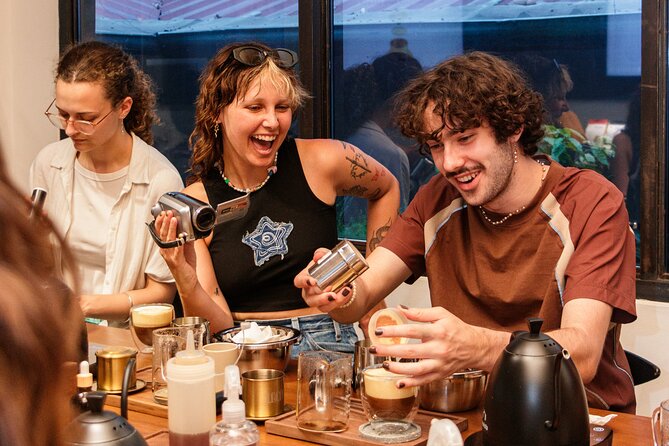
Vietnamese egg coffee holds deep cultural significance, reflecting the country’s rich coffee traditions and culinary ingenuity. This unique beverage traces its origins to 1950s Hanoi, where Vietnamese resourcefulness blossomed amid post-war austerity.
As a symbol of resilience and innovation, egg coffee represents the Vietnamese people’s ability to transform humble ingredients into something extraordinary. The custard-like consistency and robust, sweet flavor profile of egg coffee have become iconic, showcasing the country’s distinctive culinary identity.
Beyond its taste, the ritual of preparing and consuming egg coffee is deeply embedded in Vietnamese culture, fostering social connections and cherished moments. This beloved drink continues to captivate locals and visitors alike, preserving the nation’s rich coffee heritage.
Brewing Tips and Tricks
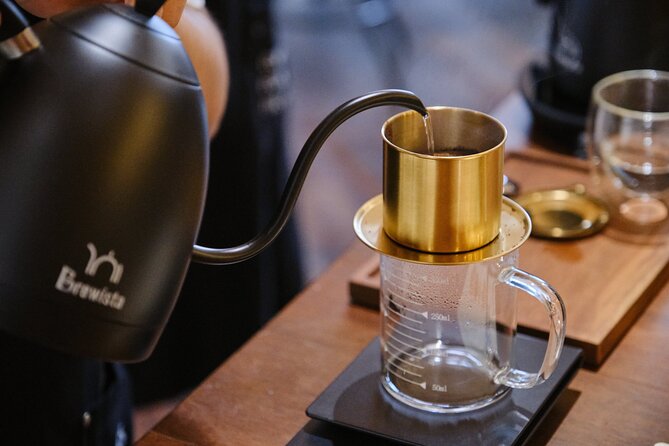
Mastering the art of brewing Vietnamese egg coffee requires attention to detail and a few key techniques.
Preparing the signature Lac’aph phin filter and blending the perfect ratio of coffee and egg are crucial steps that lend the beverage its signature creamy texture and robust flavor.
- Use freshly ground, high-quality Lac’aph coffee beans for optimal flavor.
- Carefully control the water temperature, keeping it between 195-205°F for optimal extraction.
- Gently pour the hot water over the coffee grounds in the phin filter, allowing it to slowly drip through.
- Whisk the egg yolk, condensed milk, and a small amount of hot coffee together until light and frothy before pouring over the brewed coffee.
Frequently Asked Questions
What Is the Difference Between Vietnamese and Western Egg Coffee?
Vietnamese egg coffee is made with a thick, creamy egg-yolk custard, while Western egg coffee uses a lighter, whipped egg-white foam. The Vietnamese version is richer, sweeter, and more indulgent compared to the Western style.
How Long Does It Take to Prepare an Egg Coffee?
The preparation of a Vietnamese egg coffee takes around 5-10 minutes. The barista carefully whisks the egg yolk and coffee into a creamy, frothy consistency before pouring it over a strong, dark-roasted Vietnamese coffee.
Can I Make Egg Coffee at Home Without Specialized Equipment?
Yes, you can make egg coffee at home without specialized equipment. All you need is a whisk, small bowl, and basic ingredients like eggs, sugar, and coffee. With some practice, you can recreate the signature creamy texture of Vietnamese egg coffee.
Does Egg Coffee Contain Raw Eggs, and Is It Safe to Consume?
Yes, traditional Vietnamese egg coffee does contain raw egg yolks. However, when prepared properly, the raw eggs are safe to consume. The rich, creamy texture comes from whisking the egg yolks until they’re light and frothy.
Are There Any Vegetarian or Vegan Alternatives to Traditional Egg Coffee?
Yes, there are vegetarian and vegan options for traditional Vietnamese egg coffee. Cafés may offer soy-based egg substitutes or non-dairy milks to create egg-free variants of the classic beverage.
Recap
The art of crafting Vietnamese egg coffee is a testament to the dedication and skill of its baristas. From the delicate separation of egg whites to the precise blending of coffee and cream, every step demands meticulous attention.
The result is a captivating sensory experience, where the rich, velvety sweetness beautifully complements the bold, robust flavor. This beloved specialty holds deep cultural significance, and its secrets are passed down through generations of passionate coffee enthusiasts.
More Coffee Experiences in Ho Chi Minh City
- Ho Chi Minh City: Pagodas and Coffee Corners Tour
- Egg Coffee & Course on 4 Traditional Types of Viet Coffee
- Sai Gon Special Coffee at Landmark 81 & Street Food Tour
- Hcm: Egg Coffee Class With Local Instructor & Snack
- HCMC Egg Coffee Class in 1 Hour With Local Intructor & Snack
- Tasting Iconic Coffee of 3 Regions in Vietnam
More Tour Reviews in Ho Chi Minh City
- From HCM: 2-Day Tour Mekong Delta, Cai Rang Floating Market
- From Ho Chi Minh: Mekong Delta 2 Days 1 Night
- From Ho Chi Minh: Can Gio Mangrove Forest Private Tour
- Ho Chi Minh City: Full Long Tan Battlefield Tour
- Mekong Delta 3-Day: Saigon to Phnom Penh Gateway
- From Ho Chi Minh City: Mekong Delta 2 Days Group Tour
Not for you? Here's more things to do in Ho Chi Minh City we have recnetly reviewed
- From HCM 1-Day Cai Rang Floating Market Local Mekong Village
- Phu My Port Shore Excursion Tour Cu Chi Tunnels & City Tour
- Floating Market, Flower Village Authentic Mekong Delta Tour
- 2-Day Mekong Delta Private Tour: Vinh Long, Can Tho & Sa Dec
- From Ho Chi Minh: Cai Rang Floating Market and Mekong Delta
- From Saigon: Classic Mekong Delta Full Day Tour
- Phu My Port: Ho Chi Minh City Highlights Tour
- From Ho Chi Minh: Private Vung Tau Beach Tour With Lunch
- Cat Tien National Park Private Tour With Female Tour Guide
- Ho Chi Minh City: Mekong Delta Full-Day Tour
- From Ho Chi Minh: Mekong Delta and Tra Su Forest 3D2N Tour
- Ho Chi Minh: Private Mekong Delta Day Trip With Boat Ride
